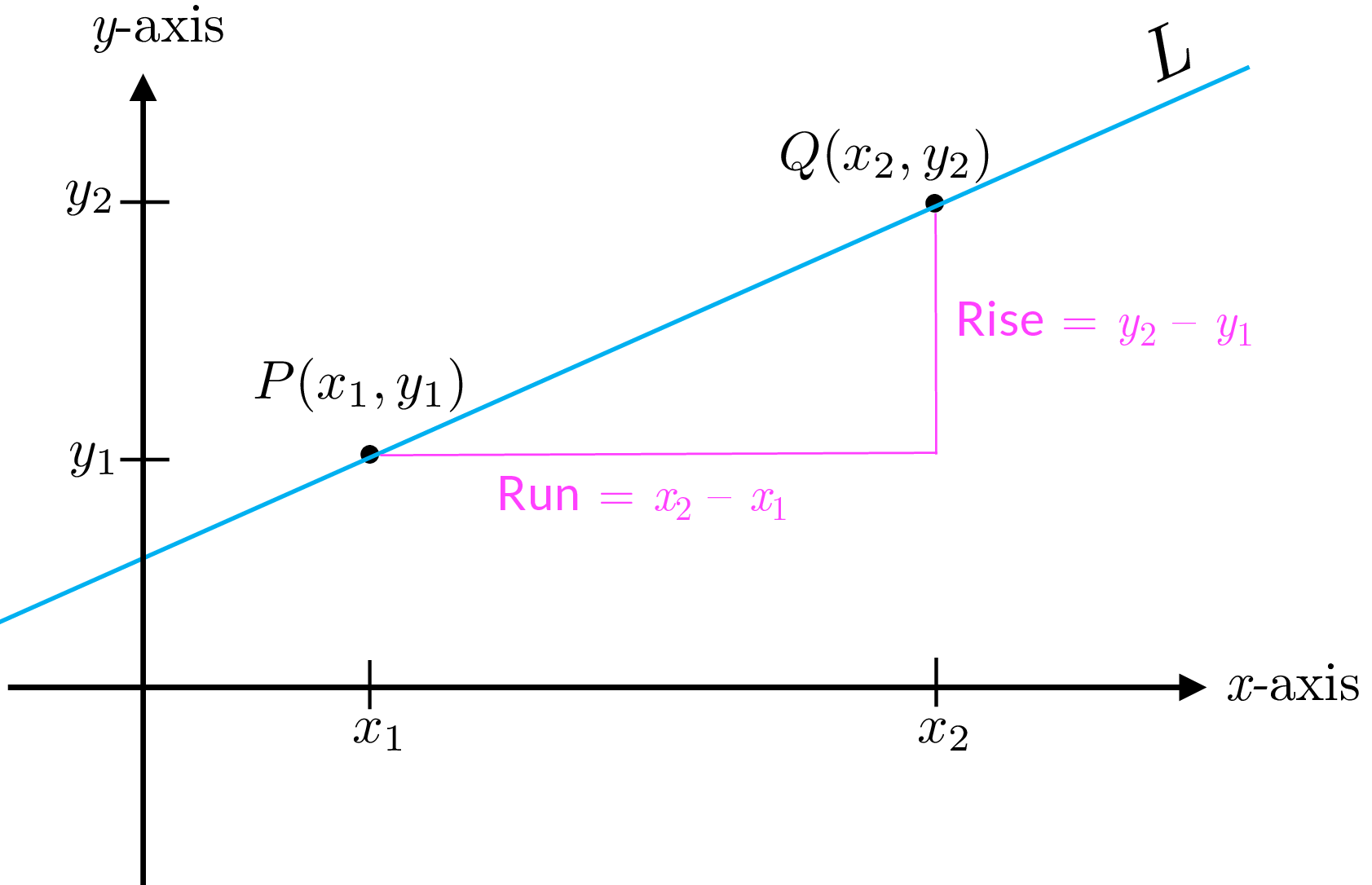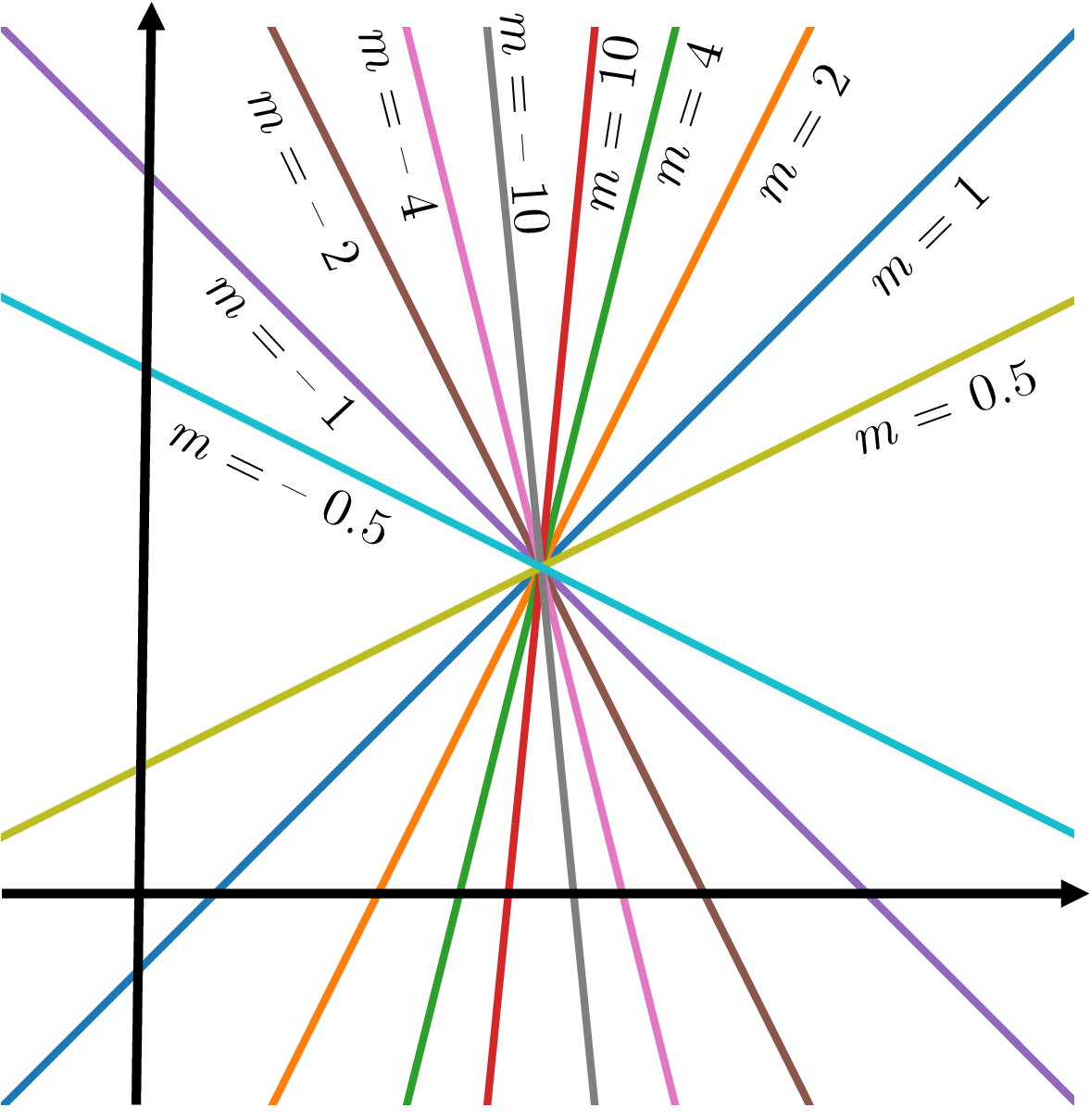Let’s study the easiest type of curves in the plane: straight lines.
Table of Contents
Slope of a Line
Consider a straight line \(L\) and two distinct points \(P(x_{1},y_{1})\) and \(Q(x_{2},y_{2})\) on it (the following figure). The slope of the line, often denoted by \(m\) , is defined to be the ratio \[\bbox[5px,border:1px solid black;background-color:#f2f2f2]{m=\frac{y_{2}-y_{1}}{x_{2}-x_{1}}.}\]
- The slope of a line is independent of which two points on the line we choose.
If \(Q\) is one unit to the right of \(P\) such that \(x_{2}-x_{1}=1\) then \(m=y_{2}-y_{1}\) . This shows if we move one unit to the right from any point on a line, the signed distance that we have to go up or down to get back on the line is the slope of the line. This is why sometimes slope is written as \[\bbox[5px,border:1px solid black;background-color:#f2f2f2]{\text{slope}=\frac{\text{rise}}{\text{run}}.}\]

The sign of the slope is related to the direction of line as follows:
- \(m>0\) , the line rises to the right
- \(m<0\) , the line falls to the right
- \(m=0\) , line is horizontal
The absolute value of the slope is a measure of steepness of the line (See the following figure).

The slope of a vertical line is not defined, because any two points on such a line have the same \(x\) coordinates, and hence when we form the ratio \((y_{2}-y_{1})/(x_{2}-x_{1})\) the denominator becomes zero and division by zero is not defined.
Equation of a Line
Now let’s find the equation of the line passing through a given point \(P(x_{1},y_{1})\) with slope \(m\) . If \((x,y)\) is any other point on this line, the slope formula gives \[\frac{y-y_{1}}{x-x_{1}}=m.\] That is, \[\bbox[5px,border:1px solid black;background-color:#f2f2f2]{y=y_{1}+m(x-x_{1}).}\] This equation is called the point-slope form of the equation of the line.
A special case of the above equation occurs when the given point is a point \((0,b)\) on the \(y\) -axis. In this case, the number \(b\) is called the \(y\) -intercept of the line and the equation of the line reduces to \[\bbox[5px,border:1px solid black;background-color:#f2f2f2]{y=mx+b,}\] which is called the slope-intercept form of the equation.
If we are given two points \((x_{1},y_{1})\) and \((x_{2},y_{2})\) on the line, then to find the equation of the line, we first have to calculate \(m\) which is \(m=(y_{2}-y_{1})/(x_{2}-x_{1})\) . Substitution of this expression for \(m\) in the point-slope form of the equation gives the point-point form : \[\bbox[5px,border:1px solid black;background-color:#f2f2f2]{y=y_{1}+\left(\frac{y_{2}-y_{1}}{x_{2}-x_{1}}\right)(x-x_{1})}\]
- The equation of a vertical line through \((x_{1},y_{1})\) is \[\bbox[5px,border:1px solid black;background-color:#f2f2f2]{x=x_{1}.}\]
General Equation of a Line
A linear equation in the variables \(x\) and \(y\) is an equation of the form: \[Ax + By + C = 0\] where \(A\) , \(B\) , and \(C\) are constants, and \(A\) and \(B\) are not both zero. Let’s see how this relates to familiar forms of lines:
- Nonvertical Line: A nonvertical line has the equation \(y = mx + b\) . We can rearrange this into the general form by subtracting \(mx + b\) from both sides: \(-mx + y - b = 0\) . This matches the general form \(Ax + By + C = 0\) with \(A = -m\) , \(B = 1\) , and \(C = -b\) .
- Vertical Line: A vertical line has the equation \(x = a\) . We can rearrange this into the general form by subtracting \(a\) from both sides: \(x - a = 0\) . This matches the general form \(Ax + By + C = 0\) with \(A = 1\) , \(B = 0\) , and \(C = -a\) .
Conversely, the graph of any linear equation \(Ax + By + C = 0\) (where A and B are not both zero) is a line. This means we can take the general form and manipulate it to find the more familiar slope-intercept or vertical line forms.
Manipulating the General Form:
If we start with \(Ax + By + C = 0\) :
- If \(B \neq 0\) : We can solve for \(y\) :
- Subtract \(Ax\) and \(C\) from both sides: \(By = -Ax - C\)
- Divide by \(B\) : \(y = (-A/B)x + (-C/B)\) This is the slope-intercept form \(y = mx + b\) , with \(m = -A/B\) and \(b = -C/B\) .
- If \(B = 0\) : The equation becomes \(Ax + C = 0\) .
- Subtract \(C\) from both sides: \(Ax = -C\)
- Divide by \(A\) (since \(A\) cannot be zero if \(B\) is zero): \(x = -C/A\) This represents a vertical line \(x = a\) with \(a = -C/A\) .
The general equation of a line is: \[Ax + By + C = 0 \tag{$A$ and $B$ not both zero}\] Every line can be expressed in this form, and every equation in this form represents a line.
Example 1. Finding the Equation of a Line with Given Point and Slope
(a) Find an equation of the line through the point \((-2, 4)\) with slope \(m = \frac{3}{4}\) .
(b) Sketch the line.
Solution
(a) Using the point-slope form with \(m = \frac{3}{4}\) , \(x_1 = -2\) , and \(y_1 = 4\) , we obtain an equation of the line as: \[\begin{align} y - 4 &= \frac{3}{4}(x - (-2)) & \text{From point-slope equation} \\ y & =\frac{3}{4}x + \frac{3}{2}+4 =\frac{3}{4}x+5.5 \end{align}\] Therefore, an equation of the desired line is \[y=\frac{3}{4} x+ 5.5.\] Alternatively, we can write the equation of the line as \[\begin{align} y - 4 &= \frac{3}{4}(x - (-2)) && \text{From point-slope equation} \\ 4(y - 4) &= 3(x + 2) && \text{Multiply by 4}\\ 4y - 16 &= 3x + 6 && \text{Distribute} \\ 3x - 4y + 22 &= 0 && \text{Rearrange} \end{align}\]
(b) The fact that the slope is \(\frac{3}{4}\) tells us that when we move to the right 4 units, the line rises 3 units. This enables us to sketch the line.
Example 2. Finding the Equation of a Line Through Two Given Points
Find an equation of the line through the points \((1, 5)\) and \((4, -1)\) .
Solution
The slope of the line is: \[m = \frac{-1 - 5}{4 - 1} = \frac{-6}{3} = -2.\] Using the point-slope form with \(x_1 = 1\) and \(y_1 = 5\) , we obtain: \[\begin{align} y - 5 &= -2(x - 1) & \text{From point-slope equation} \\ y - 5 &= -2x + 2 & \text{Distribute} \\ y &= -2x+7 & \text{Rearrange} \end{align}\] An equation of the line is \(y=-2x+7\) .
Example 3. Lines in Slope-Intercept Form
(a) Find the equation of the line with slope \(-1\) and y-intercept \(3\) .
Solution
Since \(m = -1\) and \(b = 3\) , from the slope-intercept form of the equation of a line, we get \[y = -x + 3.\]
Example 4. Find the slope and y-intercept of the line \(2y + 4x = 6\) .
Solution
We first write the equation in the form \(y = mx + b\) : \[\begin{align} 2y + 4x &= 6 \\ 2y &= -4x + 6 & \text{Subtract 4x} \\ y &= -2x + 3 & \text{Divide by 2} \end{align}\] From the slope-intercept form of the equation of a line, we see that the slope is \(m = -2\) and the y-intercept is \(b = 3\) .
Example 5. Finding Slope and y-intercept from General Form
Given the equation of a line: \[5x - 2y + 8 = 0,\] find the slope and the y-intercept of this line.
Solution
To find the slope and y-intercept, we first need to rewrite the equation in slope-intercept form, \(y = mx + b\) .
Starting with the given equation: \[5x - 2y + 8 = 0\]
We isolate the \(y\) term: \[\begin{align} -2y &= -5x - 8 & \text{Subtract 5x and 8 from both sides} \\ y &= \frac{5}{2}x + 4 & \text{Divide by -2} \end{align}\] Now that we have the equation in slope-intercept form, we can identify the slope and y-intercept.
The slope of the line is \(m = \frac{5}{2}\) , and the y-intercept is \(b = 4\) .